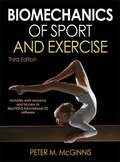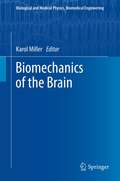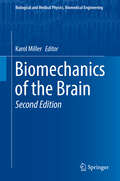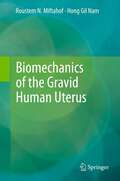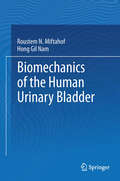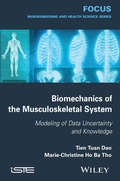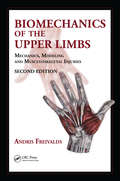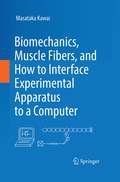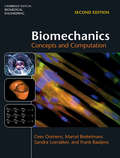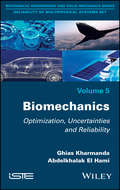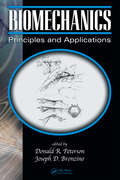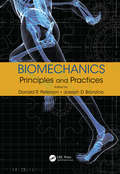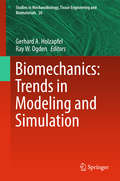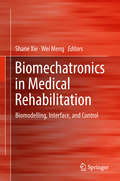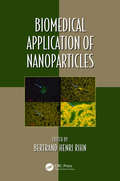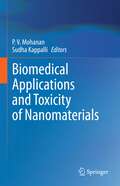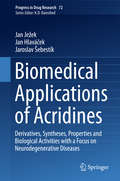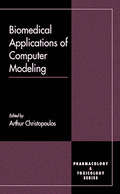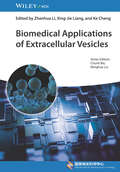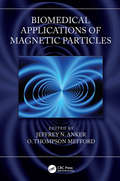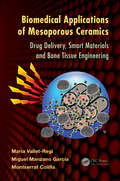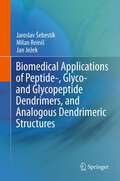- Table View
- List View
Biomechanics of Sport and Exercise
by Peter McginnisBy providing mechanics before functional anatomy, the book helps students understand forces and their effects before studying how body structures deal with forces. Students will learn to appreciate the consequences of external forces, how the body generates internal forces to maintain position, and how forces create movement in physical activities. Rather than presenting the principles as isolated and abstract, the text enables students to discover the principles of biomechanics for themselves through observation. By examining ordinary activities firsthand, students will develop meaningful explanations resulting in a deeper understanding of the underlying mechanical concepts. This practical approach combines striking visual elements with clear and concise language to encourage active learning and improved comprehension.
Biomechanics of the Brain (Biological and Medical Physics, Biomedical Engineering)
by Karol MillerBiomechanics of the Brain will present an introduction to brain anatomy for engineers and scientists. Experimental techniques such as brain imaging and brain tissue mechanical property measurement will be discussed, as well as computational methods for neuroimage analysis and modeling of brain deformations due to impacts and neurosurgical interventions. Brain trauma between the different sexes will be analyzed. Applications will include prevention and diagnosis of traumatic injuries, such as shaken baby syndrome, neurosurgical simulation and neurosurgical guidance, as well as brain structural disease modeling for diagnosis and prognosis. This book will be the first book on brain biomechanics. It will provide a comprehensive source of information on this important field for students, researchers, and medical professionals in the fields of computer-aided neurosurgery, head injury, and basic biomechanics.
Biomechanics of the Brain (Biological and Medical Physics, Biomedical Engineering)
by Karol MillerThis new edition presents an authoritative account of the current state of brain biomechanics research for engineers, scientists and medical professionals. Since the first edition in 2011, this topic has unquestionably entered into the mainstream of biomechanical research. The book brings together leading scientists in the diverse fields of anatomy, neuroimaging, image-guided neurosurgery, brain injury, solid and fluid mechanics, mathematical modelling and computer simulation to paint an inclusive picture of the rapidly evolving field.Covering topics from brain anatomy and imaging to sophisticated methods of modeling brain injury and neurosurgery (including the most recent applications of biomechanics to treat epilepsy), to the cutting edge methods in analyzing cerebrospinal fluid and blood flow, this book is the comprehensive reference in the field. Experienced researchers as well as students will find this book useful.
Biomechanics of the Gravid Human Uterus
by Roustem N. Miftahof Hong Gil NamThe complexity of human uterine function and regulation is one of the great wonders of nature and represents a daunting challenge to unravel. This book is dedicated to the biomechanical modeling of the gravid human uterus and gives an example of the application of the mechanics of solids and the theory of soft shells to explore medical problems of labor and delivery. After a brief overview of the anatomy, physiology and biomechanics of the uterus, the authors focus mainly on electromechanical wave processes, their origin, dynamics, and neuroendocrine and pharmacological modulations. In the last chapter applications, pitfalls and problems related to modeling and computer simulations of the pregnant uterus and pelvic floor structures are discussed. A collection of exercises is added at the end of each chapter to help readers with self-evaluation. The book serves as an invaluable source of information for researchers, instructors and advanced undergraduate and graduate students interested in systems biology, applied mathematics and biomedical engineering.
Biomechanics of the Human Body (Undergraduate Lecture Notes in Physics)
by Emico Okuno Luciano FratinBiomechanics of the Human Body teaches basic physics concepts using examples and problems based on the human body. The reader will also learn how the laws of mechanics may help to understand the conditions of the static and dynamic equilibrium of one of the marvels of nature: the human body. The mathematical language used in physics has always been pointed out as responsible for students' difficulties. So, each concept given is followed by explanatory examples, with subsequent application and fixation exercises. It is a richly illustrated book that facilitates the comprehension of presented concepts. Biomechanics of the Human Body can be useful to students of physical and occupational therapy, physical education, the life sciences, and health care professionals who deal with biomechanics. This book is also recommended for sport practitioners as well as the general reader interested in the mechanics of the human body.
Biomechanics of the Human Urinary Bladder
by Roustem N. Miftahof Hong Gil NamAs a research subject, the biomechanics of the urinary bladder are relatively young, yet medical problems associated with them are as old as mankind. Offering an update on recent achievements in the field, the authors highlight the underlying biological, chemical and physical processes of bladder function and present the systematic development of a mathematical model of the organ as a thin, soft biological shell. The book will be a valuable resource for postgraduate students and researchers interested in the applications of computational mathematics and solid mechanics to modern problems in biomedical engineering and medicine.
Biomechanics of the Musculoskeletal System: Modeling of Data Uncertainty and Knowledge
by Tien Tuan Dao Marie-Christine Ho ThoThe topic of this book is the modeling of data uncertainty and knowledge for a health engineering problem such as the biomechanics of the musculoskeletal system. This is the first book on this subject. It begins with the state of the art in related topics such as data uncertainty, knowledge modeling, and the biomechanics of the musculoskeletal system, followed by fundamental and theoretical aspects of this field. Clinically relevant applications of musculoskeletal system modeling are then introduced. The book finishes with a chapter on practical software and tools for knowledge modeling and reasoning purposes.
Biomechanics of the Upper Limbs: Mechanics, Modeling and Musculoskeletal Injuries, Second Edition
by Andris FreivaldsThere is already a wealth of literature covering cumulative trauma disorders and medical management, as well as the biomechanics of manual material handling and lower back problems. However, despite a spike in the number of work-related musculoskeletal disorders (WRMSDs) in the upper limbs-due to a sharp increase in the amount of computer-related j
Biomechanics, Muscle Fibers, and How to Interface Experimental Apparatus to a Computer
by Masataka KawaiThis book is written to help and enable students in how to observe biological specimens in terms of viscosity, mass, elasticity and work producing elements. The observations are related to underlying chemical reactions by means of strain (fractional length change) sensitivity of the reactions, and a theory is developed how to connect these. Their mathematical derivation is complex when three or more states are involved, but a method is presented here to demonstrate how to simplify this complex problem. Basic mathematical solutions that are useful for this book, are presented (Fourier and Laplace transforms, differential equations, matrix operations) together with Fortran programs in the Appendix.
Biomechanics: Concepts and Computation (Cambridge Texts in Biomedical Engineering)
by Cees Oomens Marcel Brekelmans Frank Baaijens Sandra LoerakkerThoroughly revised and updated for the second edition, this comprehensive textbook integrates basic and advanced concepts of mechanics with numerical methods and biomedical applications. Coverage is expanded to include a complete introduction to vector and tensor calculus, and new or fully updated chapters on biological materials and continuum mechanics, motion, deformation and rotation, and constitutive modelling of solids and fluids. Topics such as kinematics, equilibrium, and stresses and strains are also included, as well as the mechanical behaviour of fibres and the analysis of one-dimensional continuous elastic media. Numerical solution procedures based on the Finite Element Method are presented, with accompanying MATLAB-based software and dozens of new biomedical engineering examples and exercises allowing readers to practise and improve their skills. Solutions for instructors are also available online. This is the definitive guide for both undergraduate and graduate students taking courses in biomechanics.
Biomechanics: Optimization, Uncertainties and Reliability
by Abdelkhalak El Hami Ghias KharmandaIn this book, the authors present in detail several recent methodologies and algorithms that they developed during the last fifteen years. The deterministic methods account for uncertainties through empirical safety factors, which implies that the actual uncertainties in materials, geometry and loading are not truly considered. This problem becomes much more complicated when considering biomechanical applications where a number of uncertainties are encountered in the design of prosthesis systems. This book implements improved numerical strategies and algorithms that can be applied to biomechanical studies.
Biomechanics: Principles and Applications, Second Edition
by Joseph D. Bronzino Donald R. PetersonTraditionally, applications of biomechanics will model system-level aspects of the human body. As a result, the majority of technological progress to date appears in system-level device development. More recently, biomechanical initiatives are investigating biological sub-systems such as tissues, cells, and molecules. Fueled by advances in experime
Biomechanics: Principles and Practices
by Joseph D. Bronzino Donald R. PetersonThis book draws on material from the biomechanics section of The Biomedical Engineering Handbook, Fourth Edition, and includes additional chapters containing highly relevant, cutting-edge material dealing with cellular mechanics. Edited by Donald R. Peterson and Joseph D. Bronzino, it brings together contributions by world-class experts in the field. Offering an overview of major research topics in biomechanics, this is a useful resource for practitioners, scientists, and researchers in biomechanics, as well as biomedical engineering graduate students studying biomechanics, biodynamics, human performance engineering, and human factors.
Biomechanics: Trends in Modeling and Simulation (Studies in Mechanobiology, Tissue Engineering and Biomaterials #20)
by Ray W. Ogden Gerhard A. HolzapfelThe book presents a state-of-the-art overview of biomechanical and mechanobiological modeling and simulation of soft biological tissues. Seven well-known scientists working in that particular field discuss topics such as biomolecules, networks and cells as well as failure, multi-scale, agent-based, bio-chemo-mechanical and finite element models appropriate for computational analysis. Applications include arteries, the heart, vascular stents and valve implants as well as adipose, brain, collagenous and engineered tissues. The mechanics of the whole cell and sub-cellular components as well as the extracellular matrix structure and mechanotransduction are described. In particular, the formation and remodeling of stress fibers, cytoskeletal contractility, cell adhesion and the mechanical regulation of fibroblast migration in healing myocardial infarcts are discussed. The essential ingredients of continuum mechanics are provided. Constitutive models of fiber-reinforced materials with an emphasis on arterial walls and the myocardium are discussed and the important influence of residual stresses on material response emphasized. The mechanics and function of the heart, the brain and adipose tissues are discussed as well. Particular attention is focused on microstructural and multi-scale modeling, finite element implementation and simulation of cells and tissues.
Biomechatronics in Medical Rehabilitation: Biomodelling, Interface, And Control
by Shane S. Q. Xie Wei MengThis book focuses on the key technologies in developing biomechatronic systems for medical rehabilitation purposes. It includes a detailed analysis of biosignal processing, biomechanics modelling, neural and muscular interfaces, artificial actuators, robot-assisted training, clinical setup/implementation and rehabilitation robot control. Encompassing highly multidisciplinary themes in the engineering and medical fields, it presents researchers' insights into the emerging technologies and developments that are being utilized in biomechatronics for medical purposes. Presenting a detailed analysis of five key areas in rehabilitation robotics: (i) biosignal processing; (ii) biomechanics modelling; (iii) neural and muscular interfaces; (iv) artificial actuators and devices; and (v) the use of neurological and muscular interfaces in rehabilitation robots control, the book describes the design of biomechatronic systems, the methods and control systems used and the implementation and testing in order to show how they fulfil the needs of that specific area of rehabilitation. Providing a comprehensive overview of the background of biomechatronics and details of new advances in the field, it is especially useful for researchers, academics and graduates new to the field of biomechatronics engineering, and is also of interest to researchers and clinicians in the medical field who are not engineers.
Biomedical Application of Nanoparticles (Oxidative Stress and Disease)
by Bertrand RihnBiomedical Application of Nanoparticles explores nanoparticles, their chemical and physicals properties, and how they interact in biological systems with proteins, immune system and targeted cells. Risk assessment of nanoparticles for human is described, including: cellular paradigms, transcriptomics and toxicogenomics. Finally, the applications of nanoparticles in medicine and antioxidant regenerative therapeutics are presented in several chapters with emphasis on how nanoparticles enhance transport of drugs across biological membrane barriers and therefore may enhance drug bioavailability.
Biomedical Applications (Modern Aspects of Electrochemistry #55)
by Stojan S. DjokićVarious metallic or non-metallic surfaces are frequently treated by elewctrochemical methods (e.g. electrodeposition, electroless deposition, anodization, passivation, etc.) in order to achieve a desirable property important for biomedical applications. Applications include orthopedic or dental implants, dressings for wound healing and different skin diseases, surfaces for the prevention of bio-film formation of corrosion inhibition in biological media. The aim of this issue of Modern Aspects of Electrochemistry is to review the latest developments of the surface treatments for biomedical applications in relation to electrochemical science and technology. This new volume of Modern Aspect of Electrochemistry brings to the scientists, engineers and students summarized results and new concepts of surface treatments for the biomedical applications which may have significant influence for the future practical applications.
Biomedical Applications and Toxicity of Nanomaterials
by P. V. Mohanan Sudha KappalliThis book covers the recent trends on the biological applications of nanomaterials, methods for their preparation, and techniques for their characterization. Further, the book examines the fundamentals of nanotoxicity, methods to assess the toxicity of engineered nanomaterials, approaches to reduce toxicity during synthesis. It also provides an overview of the state of the art in the application of Artificial intelligence-based methodologies for evaluation of toxicity of drugs and nanoparticles. The book further discusses nanocarrier design, routes of various nanoparticle administration, nano based drug delivery systems, and the toxicity challenges associated with each drug delivery method. It presents the latest advances in the interaction of nanoparticles with the cellular environment and assess nanotoxicity of these engineered nanoparticles. The book also explores the comparative and mechanistic genotoxicity assessment of the nanomaterials. This book is useful source of information for industrial practitioners, policy makers, and other professionals in the fields of toxicology, medicine, pharmacology, food, and drugs.
Biomedical Applications of Acridines: Derivatives, Syntheses, Properties and Biological Activities with a Focus on Neurodegenerative Diseases (Progress in Drug Research #72)
by Jan Ježek Jan Hlaváček Jaroslav ŠebestíkThis book describes applications of acridines for the treatment of various neurodegenerative diseases, such as Alzheimer's disease, Parkinson's disease, and various prion diseases, and discusses the potential of acridines in neuro-regenerative medicine. Using modern data-mining software, it presents structures of acridines with nucleic acids and proteins and compares them with the native structures. Furthermore, the book presents modern methods of acridine synthesis, comparing them with the most useful conventional methods. Acridines interact with both nucleic acids and proteins, and due to their direct interactions with various enzymes, they can be suitable for the treatment of neurodegenerative diseases, inflammation, immunological disorders, and protozoal diseases. The characteristic spectral properties of acridines can be employed in labeling proteins, nucleic acids, lipids, and even cells and their compartments. Moreover, they can be applied in photodynamic therapy.
Biomedical Applications of Computer Modeling (Handbooks in Pharmacology and Toxicology)
by Arthur ChristopoulosUp to the last decade or so, most general modeling approaches to the study of molecular components of biological responses have required significant amount of computer time, expertise, and resources, as well as highly specialized and often custom-written programs. With Biomedical Applications of Computer Modeling you don't have to be a computer sci
Biomedical Applications of Extracellular Vesicles
by Zhenhua Li Xing-Jie Liang Ke ChengBiomedical Applications of Extracellular Vesicles Unique resource focusing on biomedical applications and clinical translation of extracellular vesicles in science and medicine Focusing on key points to better understand extracellular vesicles (EVs) and their development, Biomedical Applications of Extracellular Vesicles describes in detail the biogenesis of EVs, the mechanism of intercellular communication, and the treatment of various diseases of EVs and the EV-based drug delivery platforms. An application-oriented resource, the work presents rapidly newer biomedical and clinical applications of natural and engineered EVs such as drug delivery, diagnosis, prognosis monitoring, immunotherapy, and more. The first part of this book provides a basic background on EVs. Next, the book introduces the excellent therapeutic effects of EVs themselves and the underlying mechanisms, followed by how EVs from different sources were used to construct drug delivery platforms. The latest research on EVs from leading groups around the world is presented. Sample topics covered in Biomedical Applications of Extracellular Vesicles include: Biogenesis of various EVs Pros and cons of the different instrumental and methodological developments for analytical strategies applied to EVs EVs in treatment of major diseases, such as cancer, cardiovascular and respiratory diseases Current methods of engineering EVs, and a comparison of the advantages and disadvantages of each method Biomaterials, such as hydrogels, scaffolds, and microneedles, that have been developed to further enhance the therapeutic efficacy of EVs Key challenges, such as quality control, scalability, and biosafety, that limit the clinical and industrial translation of EVs Explaining in detail how extracellular vesicles are produced and engineered, along with potential applications and commercial developments of EVs in science and industry, Biomedical Applications of Extracellular Vesicles is an essential resource on the subject for chemists, cell biologists, and molecular physicists.
Biomedical Applications of Magnetic Particles
by Jeffrey N. Anker O. Thompson MeffordBiomedical Applications of Magnetic Particles discusses fundamental magnetic nanoparticle physics and chemistry and explores important biomedical applications and future challenges. The first section presents the fundamentals of the field by explaining the theory of magnetism, describing techniques to synthesize magnetic particles, detailing methods to characterize magnetic particles, and quantitatively describing the applied magnetic forces, torques, and the resultant particle motions. The second section describes the wide range of biomedical applications, including chemical sensors, cellular actuators, drug delivery, magnetic hyperthermia, magnetic resonance imaging contrast enhancement, and toxicity. Additional key features include: Covers both introduction to physics and characterization of magnetic nanoparticles and the state of the art in biomedical applications Authoritative reference for scientists and engineers for all new or old to the field Describes how the size of magnetic nanoparticles affects their magnetic properties, colloidal properties, and biological properties. Written by a team of internationally respected experts, this book provides an up-to-date authoritative reference for scientists and engineers.
Biomedical Applications of Mesoporous Ceramics: Drug Delivery, Smart Materials and Bone Tissue Engineering
by María Vallet-Regí Miguel Manzano García Montserrat ColillaDevelopments in mesoporous ceramics in drug delivery, nanomedicine, and bone tissue regeneration have opened promising developments in biomedical research, many applicable in the clinic in the near future. Due to the ability to fine-tune the physicochemical properties of these materials, the field has experienced an impressive burst in the number o
Biomedical Applications of Natural Proteins: An Emerging Era in Biomedical Sciences (SpringerBriefs in Biochemistry and Molecular Biology)
by Dhiraj Kumar Rajesh R. KundapurThis book is intended as a reference guide for graduate students, postgraduate students and researchers with a basic knowledge of protein chemistry who would like to know more about the biomedical applications of natural proteins to promote healthier lives. The book is divided into ten chapters, each of which explains different natural proteins and their established biomedical applications. The first chapter extensively deals with protein based natural fibers and provides an overview of all protein based fibers currently available. In turn, chapter two mainly focuses on the biomedical applications of a special class of proteins called Heat Shock Proteins; the biomedical applications of silkworm pupae proteins are dealt in chapter three. Chapter four examines an interesting use of Eri silk fibroin as a biomaterial for Tissue Engineering, while chapter five discusses the key experimental details involved in converting Tasar silk sericin into self-assembled nanoparticles. Chapter six offers brief descriptions of bioactive proteins with respect to their sources, synthesis and applications. Chapter seven is dedicated to Interleukine-8 and its role in human life, while chapter eight addresses the importance of natural proteins in infectious diseases. Chapter nine explores the issue of excess intake of dietary proteins and its adverse effects, and finally, chapter ten discusses the efficiency of drug delivery systems made up of gelatin nanocomposites. The book is above all intended as a valuable resource for students and researchers alike, sparking their curiosity with regard to the applications of natural proteins and motivating them to focus their own energies on the discovery or identification of additional natural proteins for diverse biomedical uses.
Biomedical Applications of Peptide-, Glyco- and Glycopeptide Dendrimers, and Analogous Dendrimeric Structures
by Jaroslav Sebestik Jan Jezek Milan ReinisDendrimers are repeatedly branched and roughly spherical large molecules. They can be used in various medical applications, such as anticancer polymeric nanomedicines and nanocarriers, gene carriers and vectors in gene delivery, contrast agents for molecular imaging and vaccines against infectious diseases and cancer. The highly branched, multivalent nature and molecular architecture of dendrimers make them ideal tools for a variety of tissue engineering applications. This book describes different categories of dendrimers, their biomedical and physico-chemical applications as well as convergent and divergent syntheses, click chemistry and ligation strategies. It is a rich source of information for researchers in biochemistry and pharmacology working on drug development as well as for organic chemists who are engaged in synthesis of dendrimers.
